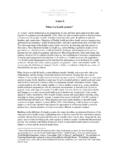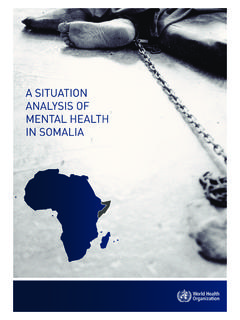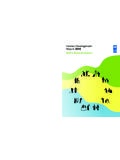Transcription of Kava: a review of the safety of traditional and ...
1 Kava: a review of the safety of traditional and recreational beverage consumption Technical report Kava: a review of the safety of traditional and recreational beverage consumption Food and Agriculture Organization of the United Nations world health Organization Rome, 2016. The designations employed and the presentation of material in this publication do not imply the expression of any opinion whatsoever on the part of the Food and Agriculture Organization of the United Nations (FAO) or of the world health Organization (WHO). concerning the legal status of any country, territory, city or area or of its authorities, or concerning the delimitation of its frontiers or boundaries. Dotted lines on maps represent approximate border lines for which there may not yet be full agreement. The mention of specific companies or products of manufacturers, whether or not these have been patented, does not imply that these are or have been endorsed or recommended by FAO or WHO in preference to others of a similar nature that are not mentioned.
2 Errors and omissions excepted, the names of proprietary products are distinguished by initial capital letters. All reasonable precautions have been taken by FAO and WHO to verify the information contained in this publication. However, the published material is being distributed without warranty of any kind, either expressed or implied. The responsibility for the interpretation and use of the material lies with the reader. In no event shall FAO and WHO be liable for damages arising from its use. The views expressed herein are those of the authors and do not necessarily represent those of FAO or WHO. ISBN 978-92-5-109291-0 (FAO). ISBN 978 92 4 151116 2 (WHO) (NLM classification: QV 766). FAO and WHO, 2016. FAO and WHO encourage the use, reproduction and dissemination of material in this information product. Except where otherwise indicated, material may be copied, downloaded and printed for private study, research and teaching purposes, provided that appropriate acknowledgement of FAO and WHO as the source and copyright holder is given and that FAO.
3 And WHO's endorsement of users' views, products or services is not implied in any way. All requests for translation and adaptation rights, and for resale and other commercial use rights should be made via or addressed to FAO information products are available on the FAO website ( ) and can be purchased through ii Con tents Summary .. vi 1 Introduction .. 1. 2. Focus of the report .. 2. traditional and recreational use of kava beverage .. 2. Use of kava extracts in medicinal products .. 3. 2 Kava varieties / beverage preparation .. 4. Kava varieties .. 4. Preparation and composition of kava beverage .. 5. Preparation .. 5. Composition .. 5. Preparation and composition of medicinal products .. 6. Limitations of the available data on kava varieties / beverage composition .. 6. 3 Kava components and their properties .. 7. Chemistry and pharmacology .. 7. 7. Pharmacokinetic drug interactions.
4 8. Toxicity .. 8. Kavalactones .. 8. Alkaloids .. 9. Flavokavins .. 9. Limitations of the available data on kava components and their properties .. 10. 4 Reported human health effects .. 11. Effects on general health .. 11. traditional kava beverage consumption .. 11. Clinical trial outcomes .. 11. Excessive kava beverage consumption .. 12. Effects on the 14. Hepatotoxicity and kava beverage consumption .. 15. Liver enzyme changes and kava beverage consumption .. 16. Human cases of kava-associated hepatotoxicity .. 17. Mechanisms/risk factors - kava-associated hepatotoxicity .. 18. Effects on cognitive 20. Effects on skin .. 21. iii Effects on chronic diseases .. 22. Limitations of the available data on human health effects .. 22. 5 consumption of kava 24. Level and frequency of consumption .. 24. Threshold intake levels for adverse effects .. 24. Limitations of the available data on consumption of kava beverage .
5 25. 6 Conclusions and future directions .. 26. Evidence for harm associated with kava beverage .. 26. Potential harm minimization strategies .. 27. Further investigations to improve safety .. 27. General areas of investigation .. 27. Specific areas of investigation to address identified data gaps .. 28. Appendix Levels of evidence .. 29. References .. 30. Tables Table Summary of evidence on the health effects of kava beverage consumption .. 13. Table Summary of the evidence on the effects on the liver following consumption of kava beverage .. 15. Table Summary of the evidence on the cognitive function effects of kava beverage consumption .. 21. Table Summary of the evidence on the skin effects of kava beverage consumption .. 22. Table Ranking of studies to determine levels of evidence .. 29. iv Acknowledgements The Food and Agriculture Organization of the United Nations (FAO) and the world health Organization (WHO) acknowledge Dr.
6 Peter Abbott, Biosearch Consulting who prepared this report , on behalf of, and in consultation with, FAO and WHO. Dr. Abbott's expertise and time is greatly appreciated. v S um mary Background to this review This review of existing information on the safety of kava when consumed as a beverage , and associated data gaps, has been prepared by FAO/WHO in response to a request from the 12th session of the FAO/WHO Coordinating Committee for North America and the South West Pacific (CCNASWP, 19-20 September 2012). It is in relation to the proposal for the development of a regional standard for kava as the dried product that can be used as a beverage when mixed with water. Kava beverage has a long history of consumption in the South Pacific and has an important role in traditional community ceremonies. In recent times, it has become more widely consumed as a recreational beverage in both the South Pacific islander community as well as in the wider international community.
7 Within these communities, kava is considered to be a safe and enjoyable beverage , based on a long tradition of use and little evidence of harm. This review has examined existing data relevant to the safety of kava beverage and identified any gaps in the available data, as well as steps that are needed to ensure the safe use of kava beverage . Consideration has been given to the method of preparation of kava beverage , the toxicity of its chemical components, the levels of consumption and the adverse health effects observed in consumers. Consideration has also been given to the relevance of the cases of hepatotoxicity that have been associated with consumption of kava medicinal products in non Pacific island countries. Kava varieties and beverage composition Kava beverage is traditionally prepared from the peeled rhizome/root of the noble kava variety; however, available information indicates that other varieties are being used either alone or mixed with noble kava to prepare kava beverage .
8 In some circumstances, other parts of the kava plant such as stems or peeling are also mixed with the rhizome/roots used to prepared kava beverage . The kava plant components vary between different parts of the plant and between kava varieties. Thus, the composition of kava beverage can be highly variable, depending on both the kava variety and the kava plant material used to prepare the beverage . There is also potential for other contaminants, such as moulds, to grow on stored kava material, some of which can produce mycotoxins such as aflatoxins. In relation to kava varieties and beverage composition, the data gaps and their impact on a safety assessment of kava beverage are as follows: Data gaps i. Comprehensive information on the source and composition of material used to prepare kava beverage . ii. Information on the composition of kava beverage , both with regard to pharmacologically active and non-active components.
9 Iii. Availability of practical and reliable analytical methods for monitoring kava components (kavalactones, alkaloids and flavokavins) and potential contaminants. In order to assess the safety of kava beverage , there is a need for: i. Improvements in agricultural and supply chain controls, to provide a consistent high-quality raw material for kava beverage preparation. vi ii. Further development of analytical techniques capable of identifying the chemical components of the kava plant, as well as contaminants, to ensure the compositional control of kava beverage preparations. Kava components and their properties The kava plant contains six major kavalactones (the active pharmacological components). as well as alkaloids and flavokavins. The metabolism of kavalactones is reasonably well understood and involves cytochrome P450 2D6, which has the potential for polymorphism. Little is known about the metabolism of the kava alkaloids or flavokavins.
10 Kavalactones can also inhibit some P450 enzymes, raising the possibility of affecting the metabolism and toxicity of co-medications. There is little evidence for kavalactone- associated in vitro cytotoxicity or in vivo hepatotoxicity in animals. Evidence of significant in vitro cytotoxicity with alkaloids and flavokavins, as well as hepatotoxicity in animals with flavokavins, has been noted and there is a case for minimizing human exposure to these components via kava beverage . In relation to kava components and their properties, the data gaps and their impact on a safety assessment of kava beverage are as follows: Data gaps i. An understanding of the potential for formation of reactive metabolites of kavalactones, alkaloids and flavokavins, and their role in kava toxicity. ii. An understanding of the potential for kavalactones to inhibit P450 enzymes, and to potentially enhance the hepatotoxicity of co-administered medication.



















